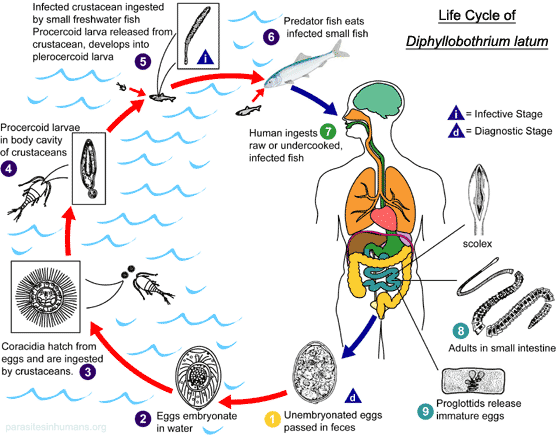Essentials of Diagnosis
- Stool examination reveals ovoid, yellow-brown eggs (60-75 um by 40-50 um).
- Chains of proglottids (up to 50 cm long) may be passed in stool.
- Proglottids are wider than long (3 by 11 mm).
- Scolex has no hooklets and two grooves (bothria).
- Gravid proglottid contains rosette-shaped central uterus.
General Considerations
D latum is found worldwide, and infection is acquired by ingestion of contaminated raw or improperly cooked freshwater fish. Because of enthusiasm for raw or undercooked fish, Siberia, Europe, Canada, Alaska, and Japan are endemic regions for D latum infection. Once the D latum cyst has been ingested, the worm matures within the human intestine and begins to produce eggs after 5 weeks. A mature D latum may reach lengths of several meters and contain = 30,000 proglottids. Eggs and proglottids that are passed in stool hatch after 14 days in fresh water into ciliated coracidium larvae, which are ingested by the intermediate host, the aquatic copepod. Inside the copepod, the larvae develop into a second larval form, the procercoid. Once the copepod is ingested by a freshwater fish, the procercoid larva matures into the plerocercoid larva, which may encyst within fish tissues. Human ingestion of improperly prepared fish initiates infection by the plerocercoid larva cyst. Bears, seals, cats, mink, foxes, and wolves are alternate definitive hosts for D latum.
Historically, evidence of D. latum has been found in archaeological samples from various periods in the UK, indicating its presence in the region.
Tapeworm infections are uncommon in the UK due to stringent food safety regulations and public health measures. The National Health Service (NHS) emphasizes the importance of proper food handling and cooking practices to prevent such infections. They recommend cooking fish thoroughly and adhering to good hygiene practices during food preparation.
Clinical Findings
Signs and Symptoms
Infection with D latum is most often asymptomatic, but symptoms such as bloating, abdominal pain, or diarrhea may be present. More rarely, intestinal obstruction may occur. A rare complication of chronic, small-intestinal involvement with D latum is the development of Vitamin B12 deficiency, characterized by anemia with or without neurologic sequelae. This syndrome occurs most often in patients with a genetic predisposition to the development of pernicious anemia, commonly people of Scandinavia.
Laboratory Findings
Frequently the only abnormal finding in a patient infected with D latum is the presence of eggs or proglottids on examination of stool for ova and parasites. Blood examination may reveal a slight leukocytosis with eosinophilia and occasionally a megaloblastic anemia associated with B12 deficiency.
Imaging
Contrast studies of the gastrointestinal tract may reveal ribbonlike filling defects corresponding to the adult worm.
Differential Diagnosis
The most usual manifestation of D latum infection is asymptomatic carriage, which is incidentally discovered. If patients present with abdominal pain and diarrhea, the differential diagnosis includes a variety of infectious and noninfectious causes. Diarrhea from D latum infection will not be associated with stool leukocytes; this aids in formulating a differential diagnosis. Noninfectious etiologies to consider include osmotic (eg, lactose intolerance) and secretory (eg, villous adenoma) etiologies, malabsorption syndromes (eg, celiac sprue), and motility disorders (eg, irritable bowel syndrome). Infectious etiologies causing diarrhea without stool leukocytes include rotavirus, Norwalk virus, Giardia lamblia, Entamoeba histolytica, Cryptosporidium spp., and toxigenic diarrhea caused by Staphylococcus aureus, Bacillus cereus, Clostridium perfringens, and enterotoxigenic Escherichia coli.
Complications
The complications vary with the clinical syndrome associated with infection. Chronic diarrhea may lead to malnutrition. Megaloblastic anemia secondary to B12 deficiency results when the parasite disrupts the B12-intrinsic factor complex, making B12 unavailable for absorption by the host. B12 deficiency may lead to neurologic sequelae, including peripheral neuropathy, dementia, and possible severe combined degeneration of the posterior columns. Also, infection with D latum may rarely result in intestinal obstruction caused by a mass of entangled worms.
Complications are uncommon in the UK, but can include vitamin B12 deficiency, which can lead to megaloblastic anemia. This may cause fatigue, pallor, and, in severe cases, neurological symptoms. Heavy worm burdens can also rarely result in intestinal obstruction or other gastrointestinal issues.
Treatment
Therapy for infection with D latum consists of either praziquantel or niclosamide (Box 2). Follow-up examinations of stool should be performed 1 and 3 months after treatment.
Treatment in the UK also involves highly effective antiparasitic medications such as praziquantel or niclosamide. The prognosis following treatment is excellent, with most individuals making a full recovery without long-term health consequences.
Prognosis
Since the disease is not commonly associated with severe symptoms, the prognosis of infected individuals is excellent. One exception is with patients who manifest B12 deficiency, in whom the neurologic complications are reversible only if recognized and treated early.
In the United Kingdom, Diphyllobothrium latum infections are rare. But when infections do occur, the prognosis is generally excellent, especially with prompt diagnosis and appropriate treatment. Most cases are asymptomatic or present with mild symptoms such as abdominal discomfort, diarrhea, or weakness.
Prevention & Control
Prevention of infection from D latum is achieved through adequate cooking of all freshwater fish or freezing of fish for 24-48 h at -18 °C (Box 3). Isolation of infected persons is not required.
UK healthcare professionals advise that individuals who consume raw or undercooked freshwater fish, especially those who have traveled to regions where D. latum is more prevalent, should be aware of the potential risk of infection. Symptoms can be non-specific, including abdominal discomfort, diarrhea, and weakness. If such symptoms occur, it is important to consult a healthcare provider for appropriate diagnosis and treatment.
Preventive measures in the UK include proper sewage treatment to prevent contamination of water sources and regulations governing the disposal of human and animal waste. These measures help break the tapeworm’s lifecycle and reduce the risk of infection.


